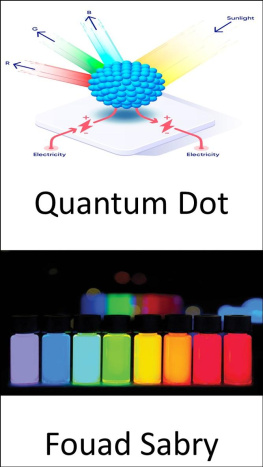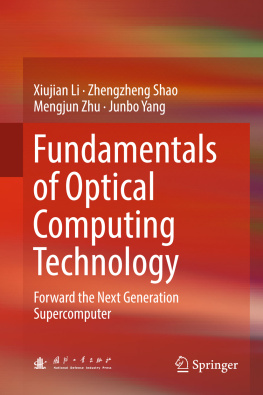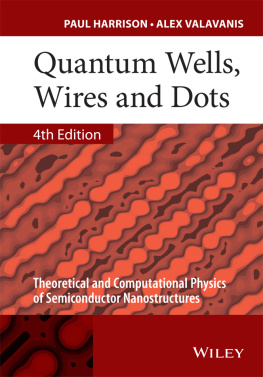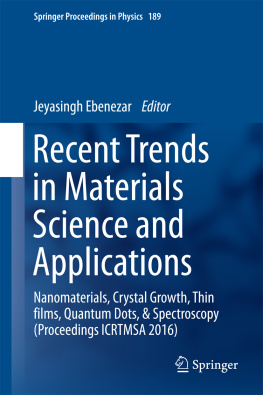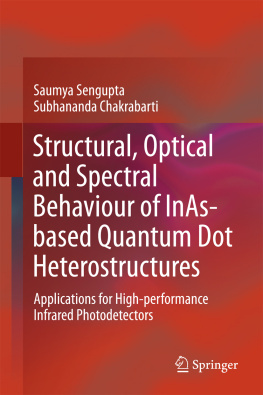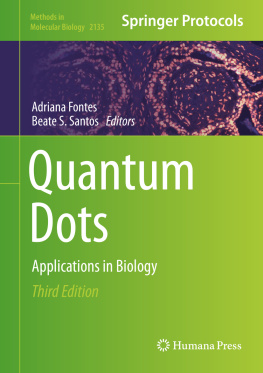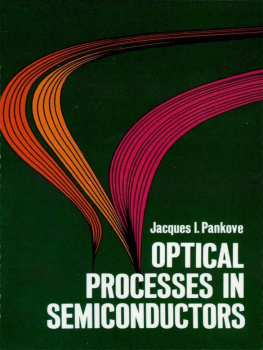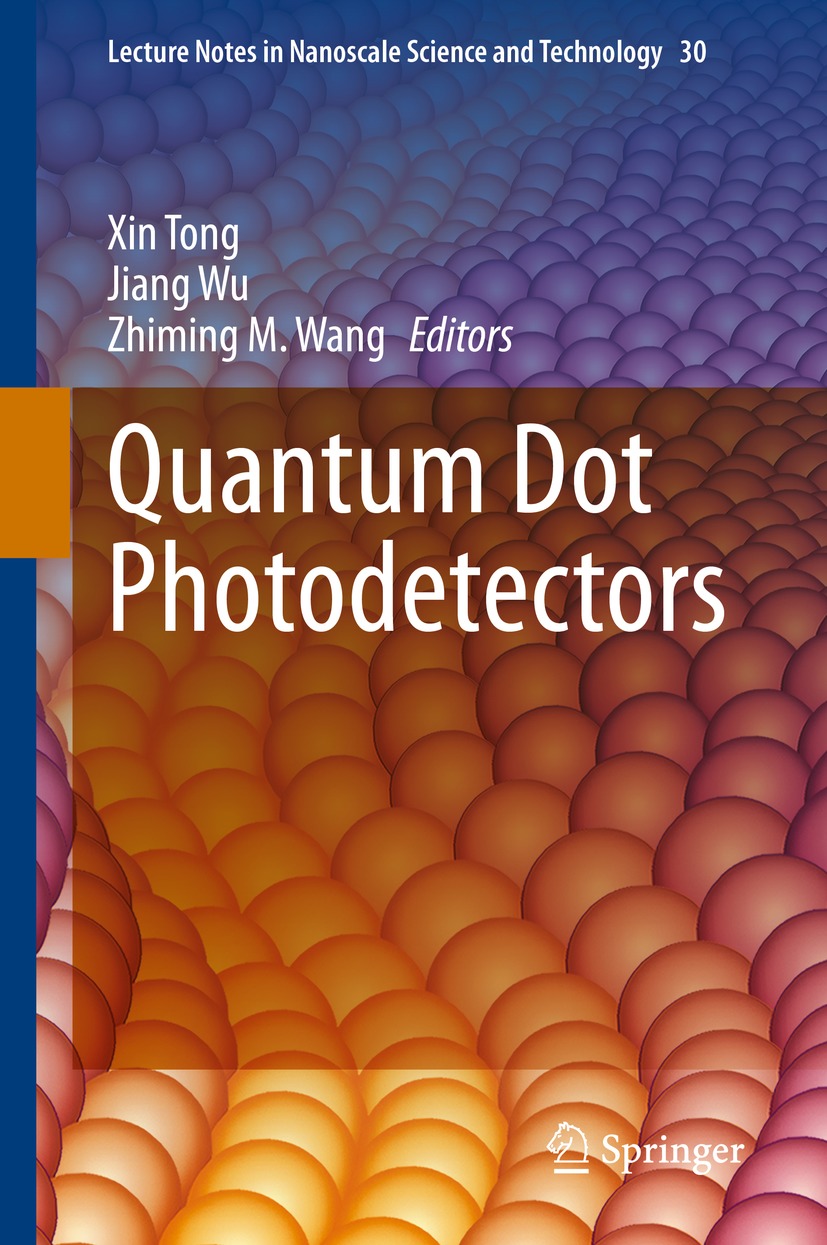Volume 30
Lecture Notes in Nanoscale Science and Technology
Series Editors
Zhiming M. Wang
Chengdu, China
Greg Salamo
Fayetteville, USA
Stefano Bellucci
Frascati RM, Italy
Lecture Notes in Nanoscale Science and Technology (LNNST) aims to report latest developments in nanoscale science and technology research and teaching quickly, informally and at a high level. Through publication, LNNST commits to serve the open communication of scientific and technological advances in the creation and use of objects at the nanometer scale, crossing the boundaries of physics, materials science, biology, chemistry, and engineering. Certainly, while historically the mysteries in each of the sciences have been very different, they have all required a relentless step-by-step pursuit to uncover the answer to a challenging scientific question, but recently many of the answers have brought questions that lie at the boundaries between the life sciences and the physical sciences and between what is fundamental and what is application. This is no accident since recent research in the physical and life sciences have each independently cut a path to the edge of their disciplines. As both paths intersect one may ask if transport of material in a cell is biology or is it physics? This intersection of curiosity makes us realize that nanoscience and technology crosses many if not all disciplines. It is this market that the proposed series of lecture notes targets.
More information about this series at http://www.springer.com/series/7544
Editors
Xin Tong , Jiang Wu and Zhiming M. Wang
Quantum Dot Photodetectors
1st ed. 2021

Logo of the publisher
Editors
Xin Tong
Institute of Fundamental and Frontier Sciences, University of Electronic Science and Technology of China, Chengdu, Sichuan, China
Jiang Wu
Institute of Fundamental and Frontier Sciences, University of Electronic Science and Technology of China, Chengdu, Sichuan, China
Zhiming M. Wang
Institute of Fundamental and Frontier Sciences, University of Electronic Science and Technology of China, Chengdu, Sichuan, China
ISSN 2195-2159 e-ISSN 2195-2167
Lecture Notes in Nanoscale Science and Technology
ISBN 978-3-030-74269-0 e-ISBN 978-3-030-74270-6
https://doi.org/10.1007/978-3-030-74270-6
The Editor(s) (if applicable) and The Author(s), under exclusive license to Springer Nature Switzerland AG 2021
This work is subject to copyright. All rights are solely and exclusively licensed by the Publisher, whether the whole or part of the material is concerned, specifically the rights of translation, reprinting, reuse of illustrations, recitation, broadcasting, reproduction on microfilms or in any other physical way, and transmission or information storage and retrieval, electronic adaptation, computer software, or by similar or dissimilar methodology now known or hereafter developed.
The use of general descriptive names, registered names, trademarks, service marks, etc. in this publication does not imply, even in the absence of a specific statement, that such names are exempt from the relevant protective laws and regulations and therefore free for general use.
The publisher, the authors and the editors are safe to assume that the advice and information in this book are believed to be true and accurate at the date of publication. Neither the publisher nor the authors or the editors give a warranty, expressed or implied, with respect to the material contained herein or for any errors or omissions that may have been made. The publisher remains neutral with regard to jurisdictional claims in published maps and institutional affiliations.
This Springer imprint is published by the registered company Springer Nature Switzerland AG
The registered company address is: Gewerbestrasse 11, 6330 Cham, Switzerland
Preface
Photodetectors are optoelectronic devices that enable conversion of photons into charge carriers to generate electric signals; they have seen widespread use in modern militaries as well as civilian life, which includes night-vision, imaging technique, optical communication, surveillance system and environment monitoring. Photodetectors can be generally classified as X-ray, ultraviolet (UV), visible and infrared (IR) photodetectors based on the detection wavelength, which can be achieved by employing various photo-active semiconductor materials with different band gaps during device fabrication. Nowadays, the majority of the commercial photodetectors used in electronic devices consist of inorganic semiconductors such as silicon and IIIV compounds, showing relatively high cost, complicated fabrication processes and limited mechanical flexibility. Thus, it is of significant importance to develop large-area and flexible photodetectors with a reduction in the size, weight, power and cost (SWaP-C) for applications in a new generation of optoelectronics.
Quantum dots (QDs) are small-sized semiconductor nanoparticles synthesized by top-down methods such as epitaxial self-assembly growth and chemical colloidal synthesis, showing outstanding light harvesting and emitting properties, which are promising for the fabrication of various optoelectronic devices including photodetectors. Generally, QDs possess a physical size smaller than the Bohr radius of bulk materials, resulting in unique quantum confinement effect that enables the size-dependent band gaps for broad absorption and tunable optical detection. Over the past few decades, several types of QDs including self-assembled QDs, colloidal II-VI/IV-VI/I-III-VI QDs, perovskite QDs, carbon QDs and their hybrids of zero dimensional QDs/two-dimensional (2D) materials with improved optical and electrical properties were developed and employed to achieve high-performance QD photodetectors, representing an exciting field that has a strong impact in terms of both physics and devices, thus paving the way for the developments of next-generation photodetectors.
This book consists of the latest advances in QD-based photodetectors including the rational synthesis of QDs, the device structure design and fabrication as well as novel optical engineering/manipulating technologies of QD photodetectors. Specifically, QD photodetectors for infrared photodetection is the major topic of the chapter , QDs preparation, fundamental properties, device types of various QD infrared photodetectors based on self-assembled QDs (e.g., InAs, GaAs) and colloidal QDs (e.g., HgTe, PbS) are reviewed. The imaging arrays techniques of QD infrared photodetectors and the comparison of colloidal QD photodetectors and HgCdTe photodiodes are discussed as well.
Chapters aims to introduce and compare the lead-based and lead-free perovskite QDs by summarizing their synthesis processes, bandgap engineering, modification methods, optoelectronic properties and photoconductor devices applications. The major challenges that need to be addressed in the future and the outlooks of perovskite QDs/NCs photodetectors were presented.
In the chapter , the application of carbon and graphene QDs (C/GQDs) in high-performance photodetectors are presented. The controlled synthesis of QDs, device structures, working mechanisms and the use of C/GQDs in hybrid structures with 2D materials for improved photodetectors performance are reviewed.



